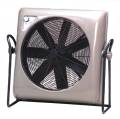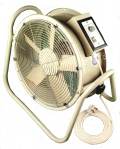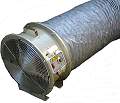
| ||||
W. Tombling Ltd.
Wembley House
Dozens Bank
West Pinchbeck
Spalding
Lincolnshire
PE11 3ND
U.K.


You are here:- home > cooling index > fan index > choosing a portable fan
Choosing a portable fan
The most common question we are asked is ‘which portable fan should I buy?’. Below are the most important things you should consider when choosing a fan.Efficiency
There are several factors that affect the efficiency of a fan:Case design – Fans housed inside casings are much more efficient than those enclosed in open wire guards. For the same diameter of fan the airflow can be upto 50% higher.Although efficient portable fans are more expensive to purchase initially, they are less costly to run than their cheaper inefficient counterparts. For a 10,000 m3/hr fan operating for 8 hours a day, 5 days a week, the extra cost is typically recouped in 4 to 6 weeks.
Fan design - axial fans are upto 70% more efficient than paddle fans. The blades of an axial fan are aerodynamically designed to move large volumes of air using the minimum amount of energy.
Speed control –many low cost fans have simple stepped speed controls. When the fan is operating at low speed, an ‘electric brake’ is applied to the motor. This wastes lots of energy, which is dissipated as heat, that can reduce the life of the motor. High efficiency portable fans use electronic speed controls that waste very little energy.
When choosing a fan always compare energy consumption, which is measured in watts. To calculate the running cost of a fan for one hour, multiply its wattage by the cost of one unit of electricity.
Fan and air noise
Careful design of the profile of the fan blades reduces noise levels considerably. Perhaps not a major consideration in a noisy factory, but definitely very important in an office, shop, restroom, etc.Noise is measured in dBA one meter from the fan, while running at full speed. When comparing fans always check the noise level, for an office or shop 60 dBA is considered to be acceptable.
Impellor size and airflow
Many people buy the biggest fan available assuming it will give the highest airflow, as noted above the design of the fan and casing have a big effect on the airflow of a fan. A large inefficient fan will certainly use the most energy, but not necessarily produce the highest airflow.When selecting a fan compare airflow not size. Airflow is measured in CFM (cubic feet per minute), m3/s (cubic meters per second) or m3/hr (cubic meters per hour).
To convert:
CFM x 0.000472 = m3/sec CFM x 1.7 = m3/hr
m3/sec x 2119 = CFM m3/hr x 0.588 = CFM
Speed control
As noted above inexpensive fans often have simple inefficient two speed controls. A portable fan with stepless electronic control will be more flexible because:The output can be set exactly at the level required for any situation.As a general rule, always choose the fan with the biggest airflow. If the airflow is too big the speed controller can easily reduce it, nothing can be done to increase the airflow of a fan that is too small.
Bigger fans can be installed, which give the option of higher outputs if needed.
Quality
The most difficult aspect to evaluate, as there are no figures to compare. Quality includes things like the materials used in construction, their thickness etc. These will depend on the intended use of the fan, for example a fan designed for light domestic use is not as durable as one built for commercial use or heavy industrial use.Look for casings that can withstand knocks and being dropped. For long term reliability the fan motors should be maintenance free and sealed for life, cables should be scuff resistant and fitted with rubberised industrial quality plugs.
Choose a fan that is designed for commercial or industrial use. Low cost domestic fans will not last very long in the typical office or factory.
Activair portable fans
Activair portable fans are designed for commercial and industrial use; they use high quality components, and are durable, efficient and quiet.Activair portable fans are available to suit most workplaces:

The Rapid500 is a variable speed ventilation and cooling fan, that is suitable for use in shops, offices, industrial units, and on construction sites.Activair portable fans are manufactured in the UK to the highest standards. Unlike low cost Far East imports they are designed for to provide years of trouble free operation, and for complete piece of mind they all have a full two year parts and labour guarantee.
Manufactured from tough impact resistant plastic and featuring electronic speed control, it is designed for years of trouble free operation.
The Rapid500 is available for use with 110V and 230V supplies.
The PF450 and PF560 are heavy duty fans, intended for use day in day out in very high temperatures, such as found in foundries, commercial laundries, kitchens, etc.
They feature tough metal casings and maintenance free, sealed for life motors, with integral thermal overload protection.
Our PF series fans produce a powerful stream of fast moving air and are particularly suited to spot cooling machinery, production processes, or workers in heavy protective clothing.The Air-jammer is our most powerful portable fan. Designed for general ventilation and cooling applications in large open spaces where high volume air movement is required.
They are widely used in factories, warehouses, and workshops. Their sleek black casings and low noise levels, also make them popular in sports halls, gymnasiums, large retail units and offices.
The Air-jammer delivers a massive 12,500m3/hr of air, enough for the most demanding applications. Because of its high output, the Air-jammer should not be used in confined spaces.
Activair portable purging fans are designed to exhaust fumes and smoke from confined spaces, and to deliver high volumes of fresh air to workers. They are supplied with 6m (19ft.) of heavy-duty flexible ducting, which allows them to supply or extract air from enclosed spaces.
They are available in 6 sizes, from 2340 m3/hr to 12,420M3/hr, and feature an electronic speed control, which allows the airflow to be adjusted from 40% to full output
You are here:- home > cooling index > fan index > choosing a portable fan
If you found this page useful, please take a moment
to tell a friend or colleague about it.
Copyright © 2003/6, W. Tombling Ltd.
